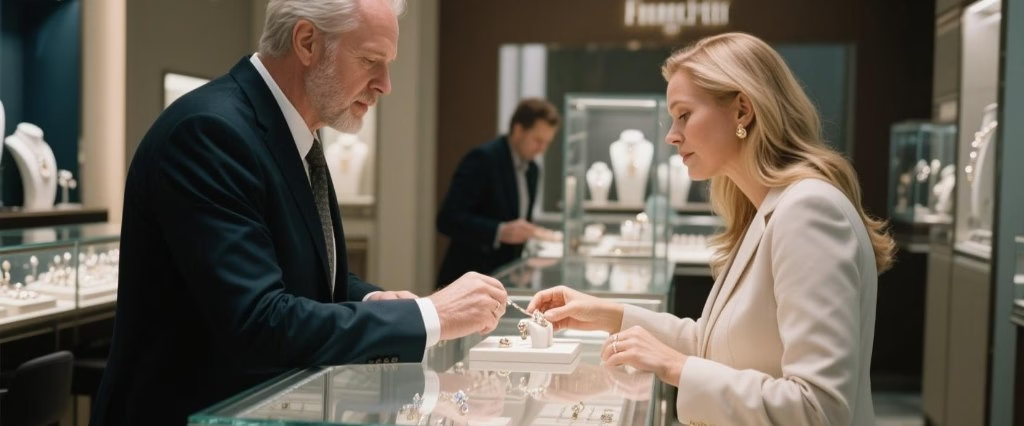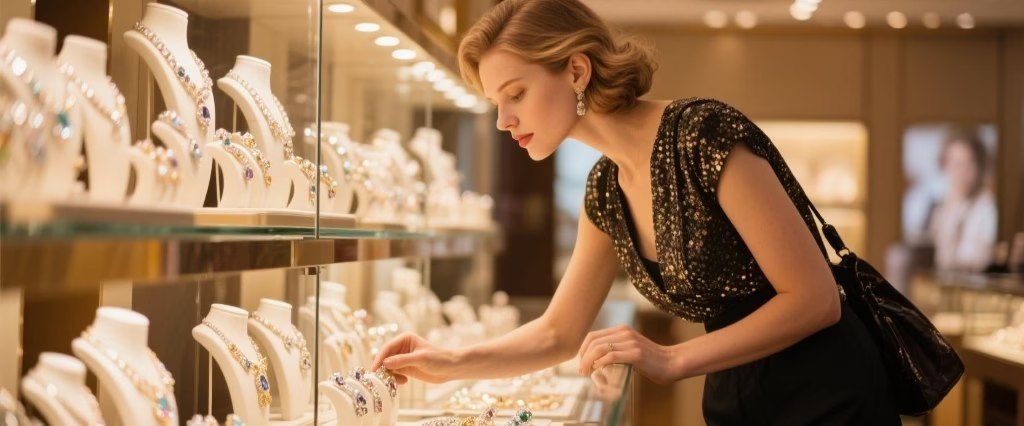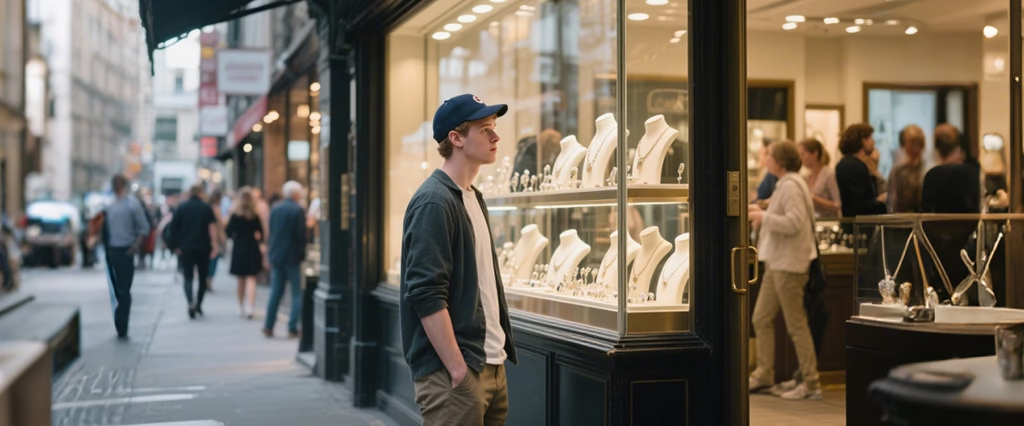The Resilience of Radiance: A Modern Jeweler’s Playbook for Thriving in Uncertain Times
In the quiet, velvet-lined world of the independent jeweler, a delicate dance is underway. It’s a dance between the timeless allure of precious stones and the volatile, fleeting anxieties of the modern world. Outside the pristine, well-lit windows of these boutiques, headlines scream of whipsawing stock markets, whispers of trade wars become roars, and a general sense of economic unease settles like a persistent fog. The buoyant confidence that once defined the post-pandemic consumer has receded, leaving in its wake a cautious, discerning, and more introspective buyer.
This is the challenging new landscape for retailers of life’s most beautiful luxuries. The “revenge spending” of 2021 and 2022, fueled by accumulated savings and a pent-up desire for joy, has faded. Even the wealthiest households, who watched their portfolios and property values soar, are now tightening their grip on their wallets. They are thinking twice, pausing longer, and asking more profound questions before making significant purchases.
“It’s unequivocally harder today than it was in 2022,” states Jackie Brooks, the CEO of Loudr, a Denver-based marketing agency with a keen eye on the luxury market. “Just a few years ago, American shoppers were flush with cash from pandemic-related savings. They were not just willing, but eager, to translate that surplus into tangible beauty, like a new piece of jewelry. That wave has crested, and the tide is now going out.”
In this atmosphere of political polarization and economic apprehension, how does a purveyor of sparkle and sentiment not only survive but thrive? The answer, according to a cohort of resilient and innovative independent jewelers, lies not in panicked discounting or aggressive sales tactics. Instead, it’s found in a profound return to the fundamentals of human connection, a strategic doubling-down on unique strengths, and the masterful use of modern tools to tell an age-old story of value and trust. This is their playbook for selling amid uncertainty.
Chapter 1: The Store as a Sanctuary: Cultivating Community Through In-Person Experiences
In an era dominated by one-click checkouts and algorithmic recommendations, the most potent weapon in the independent jeweler’s arsenal is the physical experience of their store. It’s the one thing Amazon cannot replicate: the tactile, sensory, and social environment of a beautifully curated space. Jewelers who understand this are transforming their brick-and-mortar locations from mere points of sale into vibrant community hubs.
“Walking into the store should feel like a social event,” insists Yael Reinhold Lipnik, president of , a respected four-store retailer headquartered in San Juan, Puerto Rico. She sees her stores not just as places to buy things, but as places to be. “We are constantly focused on keeping things interesting for our clients. Hosting face-to-face gatherings is foundational to that mission.” These are not your standard sales events. Reinhold Jewelers orchestrates a calendar of engaging activities, from intimate designer trunk shows where clients can meet the artist behind the piece, to creative workshops where customers might learn about gemology or even try their hand at a simple design concept. Each event is a thread, weaving the client’s personal story into the fabric of the brand.
This sentiment is powerfully echoed in the bustling metropolis of Houston. Sarah Markle Harrington, the chief operating officer of Thomas Markle Jewelers, which operates two stores in the area, recognizes that the old way of doing things is no longer enough. “We’ve absolutely had to up our game on our experiences,” she tells JCK. The evolution is tangible. “Our events now feature significantly better food—think artisan cheeses and curated culinary bites, not just crackers and dip. We have live music to create an atmosphere, and a big, inventive cocktail list that becomes a conversation piece in itself.”
The return on this investment is twofold. Harrington reports that these elevated experiences have been wildly successful, both in generating organic, enthusiastic buzz about the brand across the community and in directly boosting sales. When a client feels welcomed, entertained, and valued—without the immediate pressure to buy—they form a deep, emotional bond with the store.
This strategy is about playing the long game. As Thomai Serdari, a clinical associate professor of marketing at New York University, explains, “The modern luxury dynamic is no longer solely about the physical attributes of the product or the depth of the discounts you can offer. It’s about the ability to invite people into your world, to share your passion and expertise with them, without the unspoken expectation that they must leave with a purchase.” It’s an invitation to a relationship, not just a transaction.

Chapter 2: The Face of the Brand: Weaving Authenticity into Every Interaction
In the high-stakes world of fine jewelry, where a single purchase can represent tens of thousands of dollars and immeasurable sentimental value, trust is the ultimate currency. To earn that trust, a brand needs more than a name and a logo; it needs a face. It needs a human soul.
Jackie Brooks of Loudr emphasizes that the key to a compelling brand “face” is establishing “a brand identity that’s approachable and authentic.” This means stripping away the corporate veneer and showing the real people and passion behind the counter.
At Thomas Markle Jewelers, this principle is the North Star of their social media strategy. “We take our own photos and we do our own reels,” Harrington says, explaining their deliberate choice to eschew generic, polished images provided by vendors or stock photography services. Why? “Because I feel like people still crave a story. They want to connect with the narrative. They want to feel like they’re spending their money at a place where they are seen and feel special, a place run by people just like them.” Their Instagram feed isn’t just a catalog of rings; it’s a window into their world, featuring their staff, their store, and their genuine love for the craft.
In some cases, this principle becomes wonderfully literal. For Brandon Katzeff, CEO of Joyce’s Jewelry in Uniontown, Pennsylvania, being the face of the brand is a core part of his identity and his business strategy. “It’s so much more than just marketing,” he explains. “You need to be networking, you need to be genuinely involved in your community’s charities. I personally sit on a couple of different local boards and volunteer my time. It’s profoundly important to me to be visible and active out in the community where my clients live and work.”
This isn’t performative; it’s about deep integration. When people see Katzeff at a charity gala or a town meeting, they don’t just see a jeweler; they see a neighbor, a community leader, and a trusted figure. This builds a reservoir of goodwill that is simply priceless.
Reinhold Jewelers in Puerto Rico is leaning into this with equal conviction. “We’re leaning a little more on the fact that we’re really active in the community,” Lipnik says. Their partnerships are strategic and heartfelt. “We partner with a local women’s basketball league, a women’s business group, and various nonprofits that are doing critical work in the Puerto Rican community.”
Professor Serdari believes this is the blueprint for modern luxury retail. “Retailers should start thinking of their top customers as more of an extended family,” she advises. The logic is unassailable. “People must feel that they can fundamentally trust the individuals from whom they are buying a bracelet that costs as much as a car. This can never be a purely transactional relationship, especially for something as profoundly emotional as jewelry.”
Chapter 3: Honing Your Strengths: A Laser Focus on What You Do Best
When the economic winds are unpredictable, it’s not the time for scattered, unfocused efforts. Savvy independent jewelers are conducting a form of strategic triage, concentrating their resources, marketing budgets, and energy on their strongest and most resilient sectors.
“If I were advising a jeweler right now, I would tell them to really lean into bridal,” says marketer Jackie Brooks. “Because no matter what the stock market does, no matter who is in the White House, people are going to fall in love and get married. It’s a constant.”
Brandon Katzeff of Joyce’s Jewelry is living that advice. “We heavily, heavily market our bridal collections,” he says. “It’s our cornerstone. We maintain a huge bridal inventory to ensure we have something for every style and budget, and we focus on continuing that relationship long after the wedding.” The engagement ring is just the beginning; it’s the gateway to wedding bands, anniversary gifts, and “push presents.”
Furthermore, Katzeff has invested in the technological infrastructure to support this focus. Recognizing that the modern customer journey fluidly moves between the physical and digital worlds, he has made the shopping experience seamless. “We made a significant investment last year to update our website and become Shopify-enabled, which coordinates directly with our in-store inventory,” he says. This means customers don’t have to leave Instagram or Facebook to make a purchase. “We only promote products we have in stock and available to ship immediately. The feedback has been instant and positive.”
For other jewelers, their core strength lies in craftsmanship and personalization. Viviana Langhoff, the owner of Adornment + Theory in Chicago, has found great success by pulling back the curtain on the customization process. “When money is tight for people, I think it’s incredibly important to demystify each of the steps,” she explains. She uses her social media to show the journey of a custom piece, from initial sketch to final polish. “We make a point to say things like, ‘We work within your budget.’ When people hear the word ‘custom,’ they immediately think ‘expensive.’ Demystifying the process makes it feel far more accessible and less intimidating.”

Chapter 4: The Voice of Reason: Educating and Empowering in Anxious Times
Finally, the most sophisticated retailers are learning to talk about the issues of the day—but with a crucial caveat. They address their clients’ economic realities without magnifying their anxieties. The goal is to be a source of clarity, not a source of fear.
“I never want my marketing to come from a source of fear,” says Langhoff. “The goal is not to pile onto the existential dread that people are already feeling from the news cycle.”
In practice, this translates into creating content that educates and empowers. Instead of a panicked post about rising gold prices, this might mean a thoughtful tutorial explaining why the price of gold is climbing and what that means for the long-term value of a customer’s existing jewelry. It could be an Instagram Live Q&A clearly and calmly differentiating between lab-grown and natural diamonds, focusing on the unique value proposition of each without judgment.
“Our core demographic is Gen Z and millennials,” Langhoff notes. “A lot of our communication right now is focused on education.” This approach does something remarkable: it helps customers feel more in control. It gives them the knowledge and confidence to navigate an uncertain market, transforming them from passive consumers into informed collectors.
Andrea Hill, founder and CEO of the Chicago-based Hill Management Group, perfectly encapsulates the ultimate goal of this entire playbook. “Right now, people are scared and they are overwhelmed,” she says. The role of the brand, then, is to be a refuge. “Give people a reason to think, ‘I want to pay attention to that company—they make me feel good.’ Because a lot of things in the world don’t right now.”
In the end, the new playbook for selling jewelry in uncertain times is about selling something more than jewelry. It’s about selling community, trust, expertise, and celebration. It’s about reminding people that even in a world of turmoil, there are things that endure: love, commitment, beauty, and the profound human need to mark life’s most precious moments with something that will last forever. That is a message that will always shine brightly.



